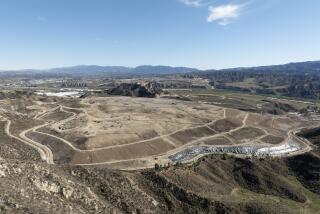Owners Treat Cemetery as a Monument to the Past
- Share via
On a windy hilltop overlooking a dusty canyon in Saugus, a tiny graveyard lies hidden by a grove of peppertrees and pines. “It’s very peaceful here,” said Andy Ponton as he walked past the aging headstones.
Ponton knows the cemetery well. He owns it.
When Ponton and his wife, Joyce, purchased nine acres in San Francisquito Canyon 11 years ago, included in the parcel was the small cemetery with graves dating back to the late 1800s. “This was a family cemetery for the Ruiz family,” he said. Although the surnames on the stones vary, the people buried there were all related to the pioneer Ruiz clan in one way or another.
Under deed restrictions placed on the property, the graves may not be removed and nothing can be built there. For the Pontons, the cemetery has become a cherished spot, a reminder of the canyon’s frontier past and a quiet place to sit and think under the shade of an old peppertree, far from traffic and mini-malls and housing tracts.
“It means an awful lot to me,” Joyce Ponton said.
Although barren in the winter and dusted with brown pine needles, the cemetery will turn green in spring. “At Easter time, daffodils grow,” she said.
Until the Pontons purchased the property and built a house, the land was unoccupied and the cemetery fell into disrepair. Vandals stole grave markers. Teen-agers partied there on Halloween. Riding clubs let their horses roam about the headstones.
The Pontons fenced off the property and keep the small gate to the cemetery locked. They repaired some grave markers, including a cross that had toppled above the grave of Niebe Ruiz, a settler who, amazingly, lived in three different centuries. “She was born in 1794 and died in 1904,” Andy Ponton said.
The cemetery is a grim reminder of the day the St. Francis Dam collapsed on March 13, 1928, sending a wall of water down the canyon that killed more than 450 people. A large marker, about 4 feet high and 11 feet across, is dedicated to the Ruiz clan. “It wiped out the family,” Andy Ponton said. “There were some that were never found.”
One grave belongs to a 10-year-old boy killed in the flood. “Nobody ever claimed his body,” Andy Ponton said. The boy was brought to the Ruiz cemetery, where a plaque reads, “In Memory of those who lost their lives in the Santa Clarita Flood, March 13, 1928.”
The Pontons are not sure how many people are buried in the cemetery, which measures 100 feet by 100 feet. Many headstones have no names at all. Others are unreadable.
Most graves date from the late 1800s and early 1900s, but a few people were buried there in the 1940s and even in 1961.
The graves of babies fill one area Joyce Ponton calls “heartbreak corner.” Many markers, such as the one for Arthur N. Rivera, feature tiny lambs carved in stone. He died in 1904 at the age of 2.
“It was tough back in those days,” Andy Ponton said.
More to Read
Sign up for Essential California
The most important California stories and recommendations in your inbox every morning.
You may occasionally receive promotional content from the Los Angeles Times.













